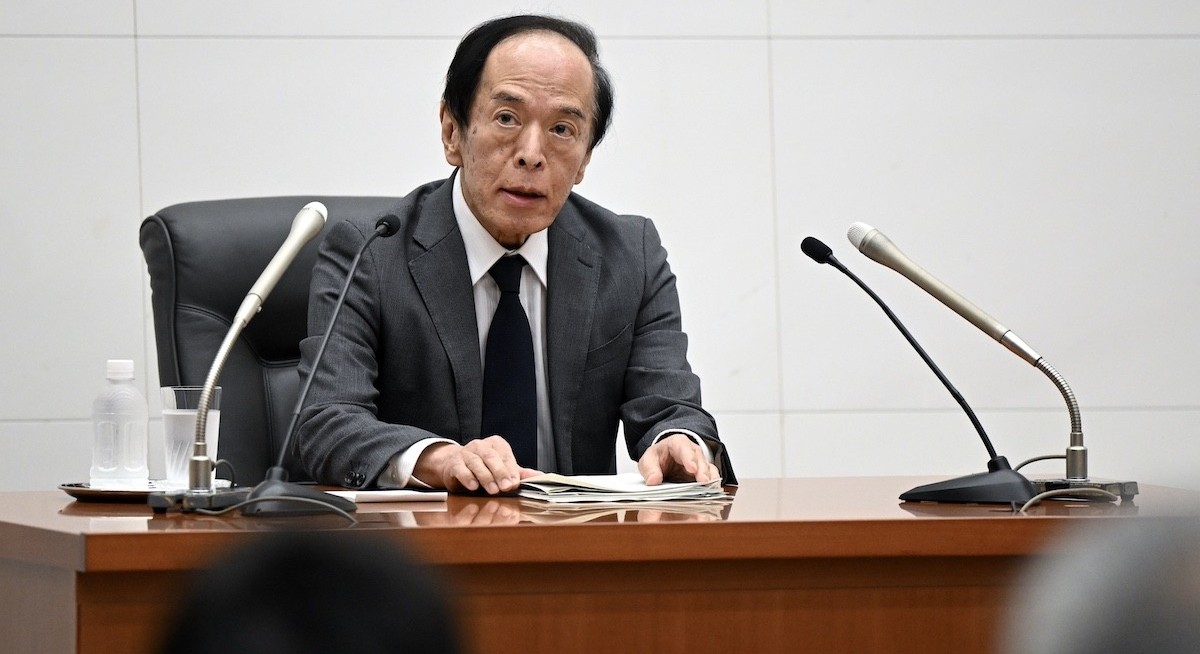Policy on hold
Despite the upgrade in its inflation outlook, the BOJ gave no direct signal on the timing of a future rate hike. Ueda notes the need to monitor the impact of US tariffs on Japan’s exports and the broader global economy. “We don’t see the fog suddenly lifting over trade,” Ueda says at his post-decision press conference. “Right now I don’t see us being behind the curve. Neither do I think there’s a high risk we’ll fall behind.”
The yen, which had been up as much as 0.6% against the US dollar earlier in the day, pared gains to 0.1% at about 149.55 at 4.50pm in Tokyo following Ueda’s comments. Japanese government bond futures also reversed early losses to trade higher.
Ueda avoided making direct comments on the currency and says inflation is trending up, but still falls short of the BOJ’s 2% target. “The BOJ’s upward revision of its price outlook does make it seem like a rate hike is coming closer,” says Hiroki Shimazu, chief strategist at MCP Asset Management. “At the same time, in the latest outlook report, the bank is also talking about an expected slowdown.”
The outlook report also reflects a change in risk balance, describing inflation risks as “generally balanced”, a shift from its earlier emphasis on downside risks for coming fiscal years. The BOJ also softened its description of trade uncertainty, noting that recent developments — such as the July 22 agreement with the US to reduce tariffs on Japanese autos and other goods to 15% — have lessened external risks.
According to sources familiar with the matter, BOJ officials expect to have enough data by year-end to consider the case for a rate hike, provided tariffs remain unchanged.
Japan remains outlier among G7 on policy tightening
See also: Tokyo inflation beats forecast, keeping BOJ on rate hike path
Japan continues to register some of the highest inflation in the G7, propelled by rising food prices and cost-of-living pressures. The central bank’s gradual stance on normalisation contrasts with the US Federal Reserve, which kept its benchmark rate unchanged this week but faces internal debate over the pace and scale of future policy moves.
Commenting on the situation, Taro Kimura, economist at Bloomberg Economics, says: “The Bank of Japan’s decision to stand pat Thursday was in line with our view that it’s taking a cautious stance as it assesses the impact of US tariffs on exports. It likely also wanted to avoid making political waves with an increase in borrowing costs at a time when the government has been weakened further by a setback in the upper house election.”
Prime Minister Shigeru Ishiba’s coalition suffered a historic loss in the July upper house poll, fuelling calls for him to step down from within his own party. Any instability could further complicate BOJ communication as it weighs future rate moves. If the BOJ does hike again, borrowing costs would reach their highest level in three decades.
Normalisation on the horizon, risks remain
Hiroaki Amemiya, investment director at Capital Group, says the BOJ’s position highlights its unique place among major central banks. “While central banks in the US and Europe have largely completed their tightening cycles and are now debating the pace of policy normalisation, the BoJ remains in a unique position as it manages the early stages of Japan’s reflation story.
“We remain cautiously optimistic about Japan’s economic potential, even amid the headwinds posed by US tariffs. Encouraging signs such as rising wages and steady domestic demand support a constructive outlook. While global trade tensions present challenges—particularly for export-driven sectors like autos and electronics—Japan’s low average tariff rate underscores its openness and positions it well for constructive engagement and potential negotiation opportunities,” says Amemiya.
Yuxuan Tang, Global Market Strategist at JP Morgan Private Bank, highlights uncertainty around the BOJ’s next move. “We believe it’s still highly uncertain whether another hike can be delivered by year-end. BOJ policymakers face a delicate balancing act between competing policy dilemmas, including sticky inflation, lukewarm consumer demand, fiscal pressures, and tariff impacts.”
To stay ahead of Singapore and the region’s corporate and economic trends, click here for Latest Section
Krishna Bhimavarapu, APAC Economist at State Street Investment Management, adds: “Today’s BoJ Outlook report left us feeling their gradually improving confidence on the economy and underlying inflation. We expect the Bank to hike once this year, potentially in October or December. However, we are yet to confirm that growth prospects remain sound for the rest of the year, something that will be clearer after the Q2 GDP data on August 15.”
On sector impacts, Rick Romano, Head of Global Real Estate Securities at PGIM Real Estate, notes: “In Japan, growth concerns from tariffs as well as political uncertainty now mean that the Bank of Japan (BOJ) is less likely to hike interest rates this year.” He points to the resilience of Japanese developers and JREITs, particularly in logistics and hospitality, while broader Asian real estate is seen as a defensive play against short-term inflation and global uncertainty.
Looking ahead, analysts broadly expect the BOJ to proceed cautiously. Most anticipate at least one more rate hike, potentially by year-end, but stress that the bank will be data-dependent given the external and political risks. The yen is likely to remain volatile in the near term, but could appreciate over the next 18 months as the rate differential with the US narrows.
For now, the BOJ’s strategy is to balance the need to anchor inflation expectations with external headwinds and domestic political pressures. Investors are advised to focus on Japanese companies with robust fundamentals, especially in technology, domestic consumption, and financial services sectors.




